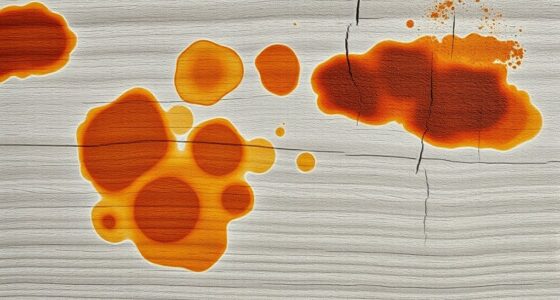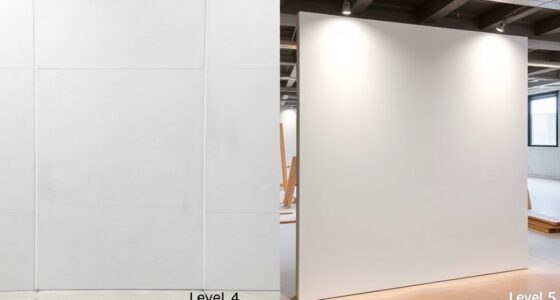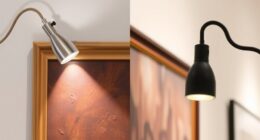Choose Venetian plaster if you want a smooth, polished finish that mimics marble and suits elegant, modern, or classical spaces like bathrooms or entryways. Tadelakt is ideal if you’re after a warm, textured, matte surface perfect for rustic or Moroccan-inspired environments, including outdoor patios or cozy kitchens. Both finishes emphasize craftsmanship and regional style. To find the best fit for your project, explore the details behind each one’s origins, techniques, and aesthetics.
Key Takeaways
- Use Venetian plaster for elegant, polished surfaces in formal, modern, or classical interiors requiring a luminous marble-like finish.
- Choose Tadelakt for rustic, warm, matte textures ideal for Moroccan, Mediterranean, or outdoor spaces emphasizing natural aesthetics.
- Opt for Venetian plaster in high-traffic areas due to its durability and resistance to scratches and wear.
- Select Tadelakt for intimate spaces like spas or cozy kitchens where a soft, organic feel enhances ambiance.
- Consider environmental factors: Venetian plaster dries faster in controlled conditions, while Tadelakt’s thicker application suits humid or outdoor environments.
Origins and Traditional Contexts of Venetian Plaster and Tadelakt
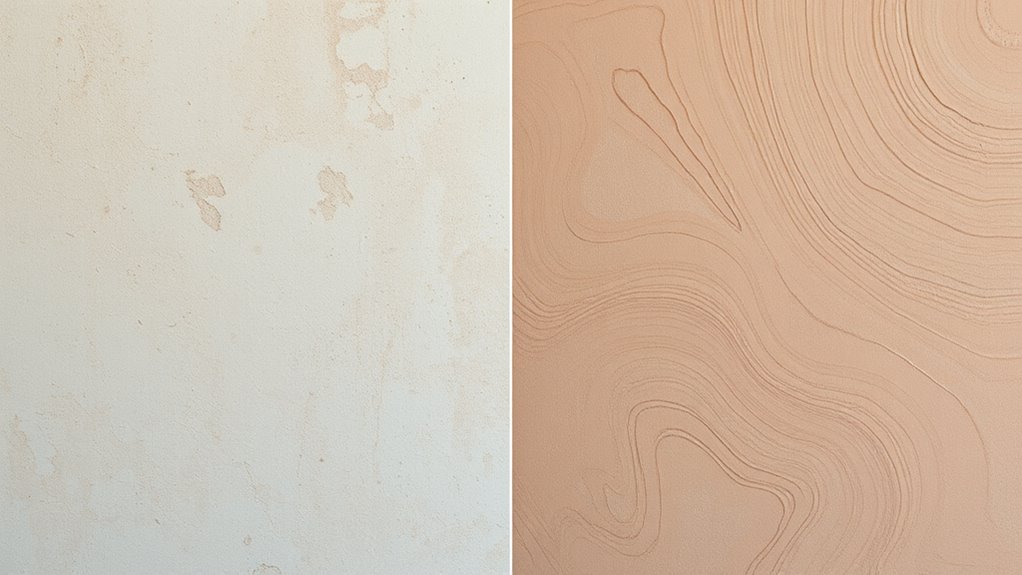
Venetian plaster and Tadelakt both have rich histories rooted in their traditional regions, shaping their unique techniques and aesthetic qualities. Venetian plaster, originating from Italy’s Veneto region, carries a deep cultural significance linked to Renaissance artistry and opulent interiors. It evolved through regional adaptations that emphasized smooth, polished finishes, reflecting wealth and sophistication. Conversely, Tadelakt hails from Morocco’s Marrakech area, where its cultural significance is tied to Islamic architecture and communal spaces. Its regional adaptations incorporate natural lime and subtle polishing techniques suited to the climate and local materials. Both finishes serve more than decoration—they embody cultural identity, tradition, and regional craftsmanship, making them not just decorative choices but meaningful expressions of their origins. Additionally, understanding the traditional craftsmanship involved can help in selecting the appropriate finish for specific architectural contexts. The techniques used in each craft are closely linked to the materials available and the climate of their regions, which influence their durability and appearance.
Material Composition and Application Techniques
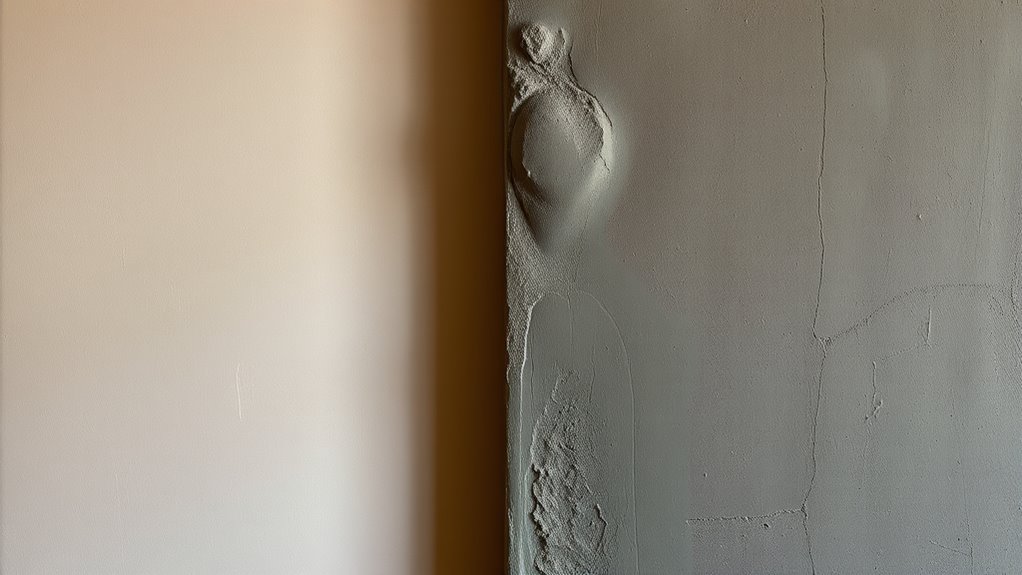
You’ll notice that Venetian plaster and Tadelakt use different materials, which influence their textures and finishes. Their application techniques also vary, requiring specific tools and methods to achieve the desired look. Understanding these composition differences and process variations helps you choose the right technique for your project. For example, the use of specialized tools in Tadelakt can impact the smoothness and waterproof qualities of the finish. Additionally, knowledge of material composition assists in selecting the appropriate treatment and maintenance methods for each finish. Recognizing the impact of application methods on the final appearance ensures you can customize your project according to aesthetic and functional needs. Moreover, embracing creative practice can help you experiment with different techniques to achieve unique textures and styles.
Composition Differences Explored
While both Venetian plaster and Tadelakt create smooth, polished surfaces, their materials and application techniques differ markedly. Venetian plaster primarily uses lime or marble dust mixed with pigments and binders, creating a versatile, breathable finish. Tadelakt, on the other hand, employs a lime-based plaster combined with natural pigments, which is applied in thicker layers. The key difference lies in surface sealing: Venetian plaster often requires waxing or polishing to achieve shine and durability, while Tadelakt is sealed with a natural soap solution, making it water-resistant. These composition differences influence not only the look and feel but also the maintenance and suitability for various environments. Understanding these distinctions helps you choose the right finish based on your project needs. For example, specialized application techniques can impact the final appearance and longevity of each finish. Additionally, the material composition directly affects the environmental resilience and upkeep requirements of the surfaces, which can also tie into personal preferences for eco-friendly materials. Moreover, considering application environment can guide you in selecting the most appropriate finish for high-moisture or outdoor settings.
Application Method Variations
The application techniques for Venetian plaster and Tadelakt vary considerably due to their material compositions. Venetian plaster typically involves multiple thin layers applied with trowels, sponges, or spatulas, creating a smooth, polished surface. Tool variations allow for different textures and finishes, from matte to high gloss. In contrast, Tadelakt relies on a single, thick layer applied with a rounded stone or rubber mitt, emphasizing a more seamless, matte, and waterproof finish. The application techniques differ because Venetian plaster demands precise, layered application, while Tadelakt requires a more fluid, continuous process. Mastering these tool variations guarantees you achieve the desired look and durability, making each technique suitable for specific aesthetic and functional needs. Additionally, understanding the application methods helps in selecting the appropriate technique based on the desired surface appearance and environmental conditions. Recognizing the material composition of each finish guides artisans in choosing compatible tools and application styles to ensure long-lasting results. For example, the choice of finishing tools can significantly influence the final texture and sheen of the surface. Being aware of the application environment is also crucial, as humidity and temperature can affect the drying time and adhesion of each material.
Visual Aesthetics and Texture Differences
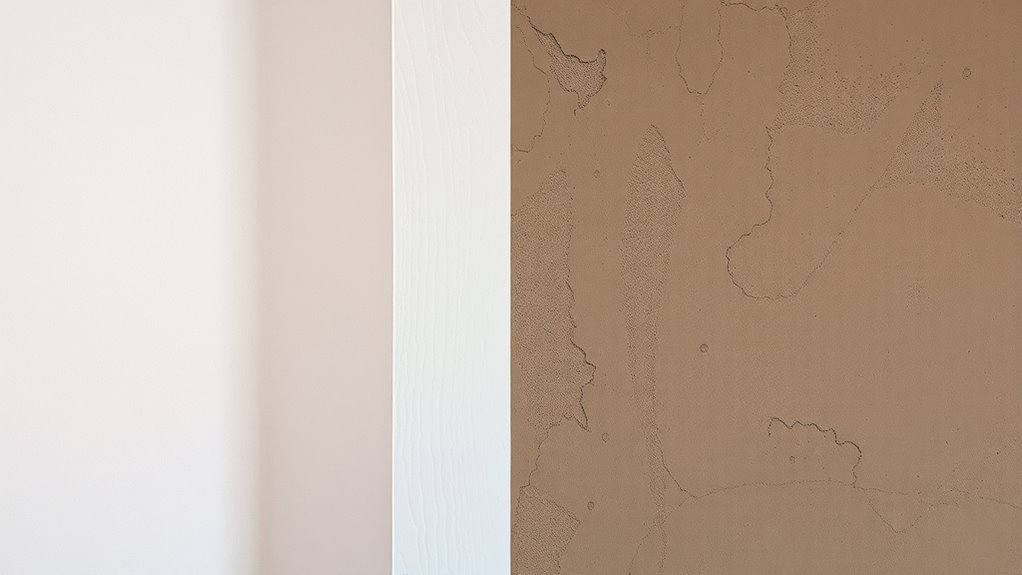
Venetian plaster and Tadelakt each bring distinct visual and tactile qualities to a space, allowing you to achieve different aesthetic effects. Venetian plaster offers a smooth, polished surface with a subtle sheen that enhances a refined, elegant look. Its color palette is versatile, ranging from soft neutrals to bold hues, and it creates a luminous, almost marble-like appearance. Tadelakt, on the other hand, features a matte, slightly textured surface that exudes warmth and authenticity. Its tactile quality is soft and velvety, inviting touch. The visual aesthetics of Tadelakt are more organic and earthy, often emphasizing natural tones and subtle imperfections. Both finishes considerably influence the mood of a space, but their distinct textures and visual appeal serve different stylistic goals. Additionally, the choice between them can be influenced by their material composition, which impacts durability and maintenance considerations. Understanding application techniques can further help in selecting the right finish for your project. Moreover, recognizing the visual texture and material characteristics can assist in achieving the desired ambiance and functional properties. Being aware of regional preferences may also guide your selection based on local styles and climate considerations.
Durability and Maintenance Considerations
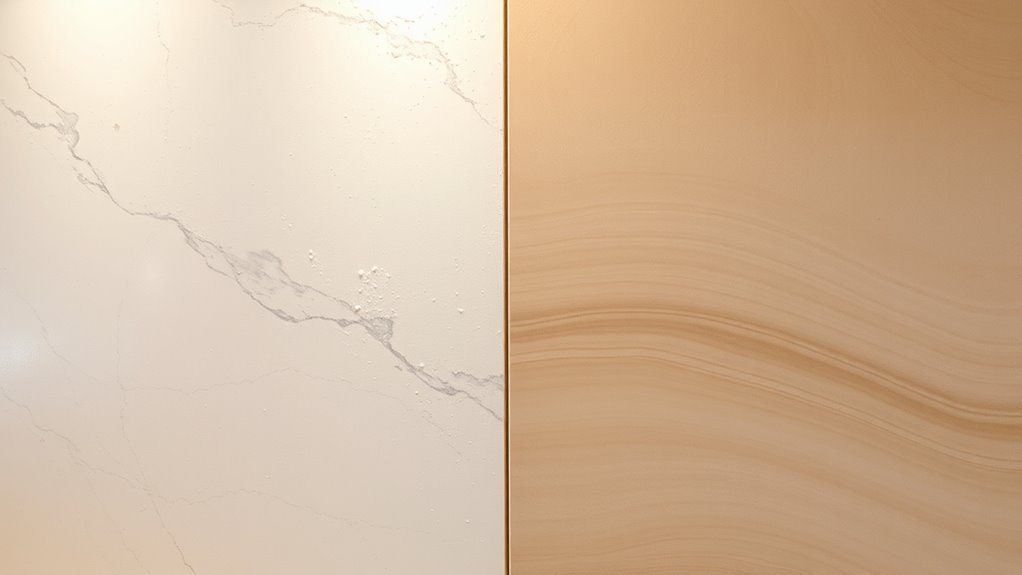
When choosing between Venetian plaster and Tadelakt, it’s important to contemplate their resistance to wear and how easy they are to clean and maintain over time. You’ll want surfaces that can stand up to daily use and minor damages with minimal effort. Additionally, understanding how simple it is to repair or restore each finish can save you time and money in the long run. Considering the durability of heat pump systems can also inform decisions about maintaining climate control in your space.
Resistance to Wear
While both Venetian plaster and Tadelakt offer appealing finishes, their resistance to wear varies markedly. Venetian plaster generally provides higher surface resilience, making it more scratch-resistant and suitable for high-traffic areas. Its layered application creates a durable surface that can withstand daily knocks and abrasions. Surface durability is a key factor when choosing between the two finishes. Tadelakt, on the other hand, has a softer, more natural feel, but its surface resilience is lower, so it’s more prone to scratches and surface damage over time. If you need a finish that endures frequent contact and maintains its appearance, Venetian plaster is the better choice. Tadelakt requires more careful handling and occasional touch-ups to preserve its integrity. Additionally, understanding the properties of different plaster materials can help you select the most appropriate finish for your space. For example, application techniques can influence the longevity and resistance of each finish. Proper maintenance practices are also essential for extending the life of Tadelakt and maintaining its aesthetic appeal. Ultimately, your decision depends on the specific wear demands of your space.
Cleaning and Upkeep
Because Venetian plaster offers greater wear resistance, it generally requires less maintenance to keep its finish looking pristine. Regular cleaning techniques involve gentle dusting and occasional damp cloth wiping, avoiding harsh chemicals that could damage the surface. Tadelakt, being more porous, needs more careful upkeep routines, like using mild soap and water to prevent staining or grime buildup. For both finishes, avoid abrasive scrubbers or acidic cleaners, as these can compromise the surface’s integrity. Consistent maintenance helps preserve their aesthetic appeal and durability over time. While Venetian plaster is more forgiving with cleaning, Tadelakt’s natural finish demands a more delicate approach to ensure longevity. Additionally, incorporating proper sealing techniques can further enhance the resistance of both surfaces and extend their lifespan. Regular upkeep routines, combined with gentle cleaning methods, extend the life and beauty of each surface.
Repair and Restoration
Venetian plaster is generally easier to repair due to its dense, less porous surface, which allows for quick touch-ups and reapplication of layers to blend imperfections seamlessly. Its historical influence on architecture means repairs often preserve its traditional appearance, maintaining cultural significance. You can patch minor cracks or chips with minimal effort, and the layered finish helps hide repairs, extending durability. Tadelakt, however, is more delicate and porous, requiring careful restoration to prevent damage. Its natural, centuries-old appeal makes it a cherished feature in historic buildings, but repairs demand specialized techniques to respect its authenticity. When considering long-term maintenance, Venetian plaster offers more straightforward solutions, while Tadelakt’s restoration requires attention to its unique finish and cultural value.
Ideal Spaces and Architectural Styles for Each
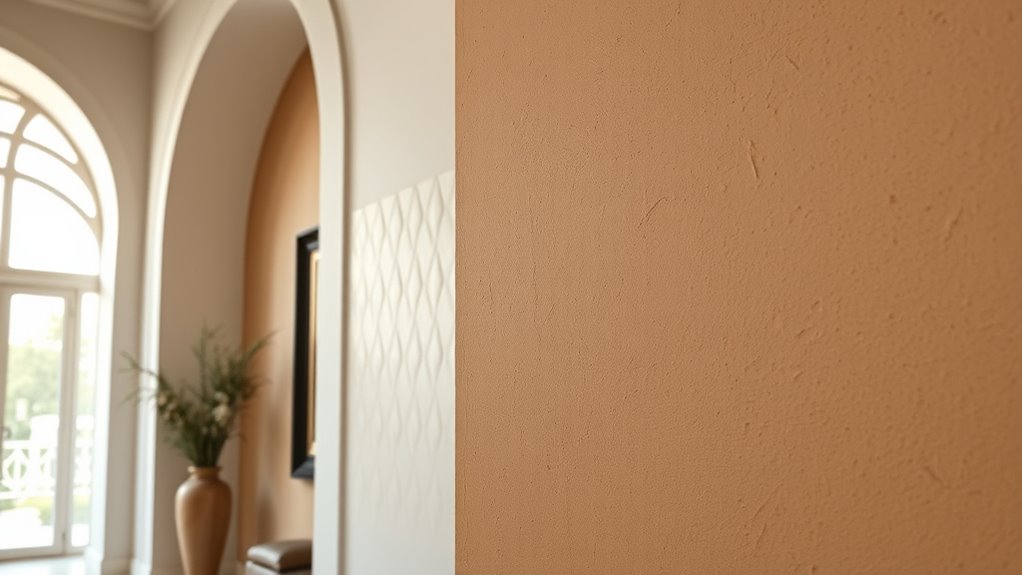
Both Venetian plaster and Tadelakt bring unique character to various spaces, making them suitable for different architectural styles. Venetian plaster’s smooth, polished finish adds a luxury appeal, perfect for elegant, modern interiors or classical designs that emphasize sophistication. It works well in formal living rooms, grand entryways, or luxurious bathrooms where you want a refined look. Tadelakt, with its matte, slightly textured surface, exudes rustic charm and pairs beautifully with Mediterranean, Moroccan, or traditional designs. It’s ideal for spaces that embrace warmth and natural materials, such as cozy kitchens, spas, or outdoor patios. Depending on your style—whether polished luxury or rustic authenticity—each finish enhances the space’s character and complements your overall aesthetic.
Environmental Impact and Sustainability Factors
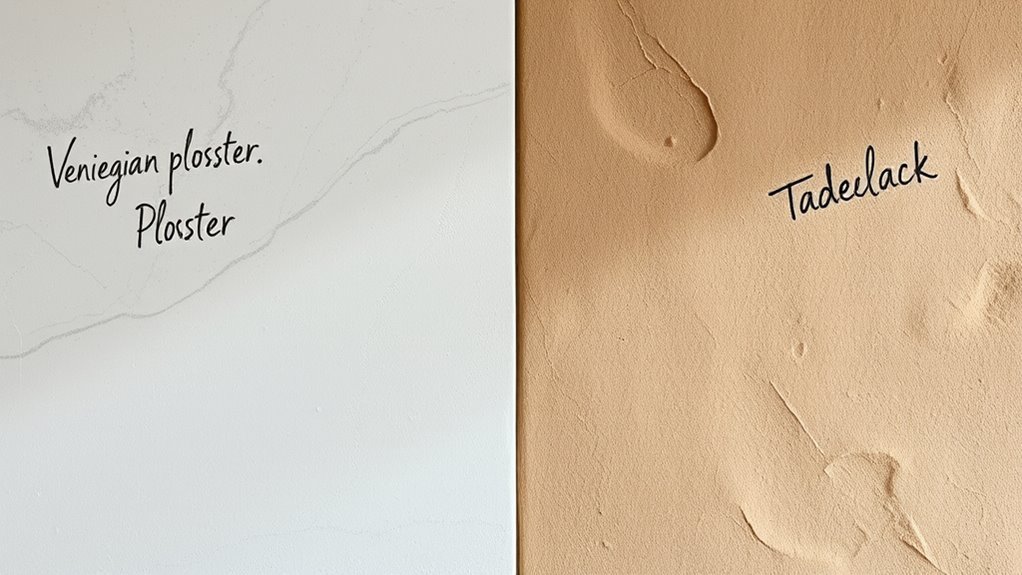
When considering the environmental impact of Venetian plaster and Tadelakt, it’s important to evaluate how each material aligns with sustainable building practices. Both options can be environmentally friendly if you choose eco friendly materials and prioritize sustainable sourcing. Venetian plaster often uses natural lime and marble dust, which are biodegradable and have low VOC emissions. Tadelakt, traditionally made with lime plaster and natural pigments, also supports sustainability through its minimal chemical additives. By sourcing these materials responsibly, you reduce your ecological footprint. Additionally, their durability means fewer replacements, minimizing waste over time. Both techniques promote eco-conscious choices, but verifying suppliers’ sustainability practices ensures you’re making the most environmentally responsible decision. Ultimately, your selection can contribute to a greener, healthier space.
Cost and Time Investment for Installation
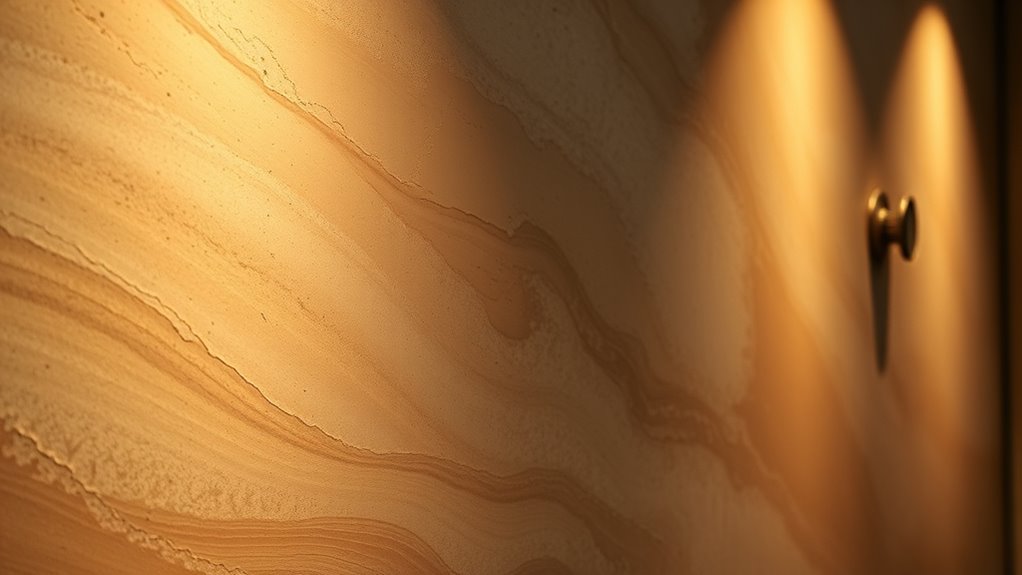
Installing Venetian plaster or Tadelakt requires a significant investment of both time and money, with the exact costs depending on factors like project size, complexity, and the skill level of your installer. The cost comparison between the two finishes varies; Venetian plaster often costs more upfront due to its materials and detailed application process. When considering installation duration, Venetian plaster typically takes longer because it involves multiple layers and polishing, whereas Tadelakt can be quicker but still demands careful application and curing time. Your choice will influence your overall budget and schedule. Keep in mind that high-quality craftsmanship can increase costs but ensures durability and a refined finish. Planning for these factors helps you make an informed decision aligned with your project scope and timeline.
Tips for Choosing the Right Finish for Your Project

Choosing the right finish for your project depends on several factors, including your aesthetic preferences, budget, and timeline. Consider the color options available—both Venetian plaster and Tadelakt offer rich, earthy tones, but Tadelakt’s natural look may appeal if you want a more authentic feel. Faux finishes can mimic these textures at a lower cost and quicker installation, which might suit tight deadlines. Think about the durability you need; Venetian plaster provides a polished surface, while Tadelakt is more water-resistant. Your decision should also reflect the space’s purpose—faux finishes can replicate these textures easily in less prominent areas. Ultimately, weigh your style, maintenance needs, and budget to select the finish that enhances your space best.
Frequently Asked Questions
How Do Venetian Plaster and Tadelakt Compare in Thermal Insulation?
Venetian plaster and tadelakt both offer some thermal properties, but their insulation performance isn’t their main strength. Venetian plaster, with its smooth, dense surface, provides limited insulation, while tadelakt’s lime-based material offers slightly better thermal mass, helping regulate temperature. However, neither is ideal for primary insulation. For better thermal performance, consider adding insulation layers behind these finishes, as they mainly enhance aesthetics and moisture resistance.
Are There Health Considerations When Choosing Between Venetian Plaster and Tadelakt?
You should consider toxicity concerns and allergen risks when choosing between Venetian plaster and Tadelakt. Venetian plaster typically contains natural ingredients and low VOCs, making it a safer option for sensitive individuals. Tadelakt, while natural, may involve lime-based materials that could cause irritation for some. Always check product labels for potential allergens or toxins, and opt for those with minimal chemical additives to protect your health.
Can Venetian Plaster or Tadelakt Be Used Outdoors Effectively?
Like a chameleon adapting to its environment, you can use Venetian plaster and Tadelakt outdoors, but with caution. Venetian plaster offers limited weather resistance, making it less ideal for harsh conditions. Tadelakt, however, boasts better moisture resistance and weather durability. Both provide aesthetic versatility, so choose Tadelakt for outdoor walls to guarantee longevity, while Venetian plaster is best suited for protected outdoor areas or covered patios.
What Are the Best Sealing Methods for Each Finish?
You should choose sealants compatible with each finish and apply them using proper techniques. For Venetian plaster, use a breathable, high-quality sealant that enhances its glossy look without trapping moisture, applying thin coats evenly. For Tadelakt, opt for natural, lime-based sealants that penetrate well, and guarantee you use gentle, consistent application techniques to preserve its matte, waterproof surface. Proper sealing prolongs durability and maintains aesthetic appeal for both finishes.
How Do Maintenance Routines Differ Over Decades?
Over decades, your maintenance routines differ based on long-term durability and aesthetic aging. For Venetian plaster, you’ll want regular gentle cleaning and occasional polishing to preserve its shine and prevent cracks. Tadelakt requires periodic re-sealing and gentle washing to maintain its smooth, matte finish. Both finishes benefit from timely repairs to address minor damages, ensuring their beauty endures and their aesthetic appeal ages gracefully over time.
Conclusion
Choosing between Venetian plaster and tadelakt is like selecting the perfect brushstroke for a masterpiece. Both finishes bring unique beauty and character to your space, but understanding their origins, textures, and durability helps you make the best choice. Think of it as selecting the right melody for your home’s symphony—each has its own tune. Trust your instincts, consider your environment, and you’ll craft a space as stunning and harmonious as a well-composed song.



